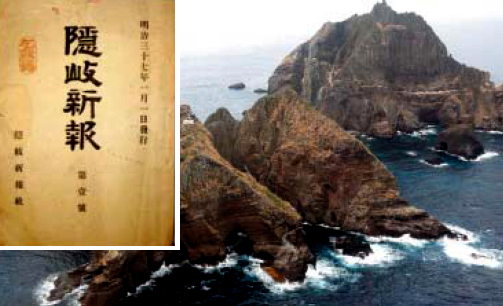
Korea's online edition of the
Chosun Ilbo has posted a November 7, 2009 article entitled,
"1905 Edition of 'Oki Sinbo' ---Evidence of 'not original territory,'" which says that a researcher at the
Korea Maritime Institute's Dokdo Research Center has found evidence in a March 1905 Japanese publication that the Japanese claim that "Dokdo" was "originally" Japanese territory is "a lie."
The researcher, whose name is Yu Mi-rin, supposedly said that the following sentence from a March 1905 article, entitled "Oki Boundary Expanded," in the
Oki Sinbo (隱岐新報) is the evidence that Japanese are lying:
It is a happy event that two small islands and several islets, which our islanders have traveled to since ancient times, have been officially named Takeshima (竹島) and made a part of Oki territory.
우리 도민이 예로부터 도항하던 두 개의 섬과 많은 작은 섬들이 공식적으로 다케시마(竹島·독도를 일본에서 일컫는 말)라는 이름으로 오키 영토가 된 건 기쁜 일.
Here is the original Japanese with an English translation (courtesy of Kaneganese):
隱岐國境土の膨張
隱岐の西北八十五浬を距る海洋に存在する島嶼を竹島と命名し隱岐の新領土として隱岐島司の管轄に屬せしめられぬ、吾人豈太白を浮べて祝せざるを得んや、抑も竹島の地たる姉妹二つの島嶼、數多の小島嶼以て點々包圍せられ、其面積の如き未だ詳にせずと雖も、棲居敢て凌ぎ得ざるにあらずといふ、而して陸産としては殆んど利するものなきも、海産に於ては海獣其他漁利鮮なからずと聞く、由來我島民中夙に仝島に航して獲たる所のもの少なからず、事實上隱岐の領土に屬し居りしは既に久し、然るに公然之を認められざりしは遺憾の感ありしに、今や公認の令に接するを得たる上は我島民たるもの大に期する所なかるべからず、然れども仝島固と狭小なり、産物の濫採は永久の利を得る所以にあらざれば一時の利を競ふて無限の利を顧みざるが如きことなきを要す、當局者たる者亦大に此點に留意する所なかるべからず、兎に角隠岐の地籍に新領の上るは何れの町村の所属となるにせよ、確かに隱岐の一大幸福たり、吾人は快感禁じ難く玆に一言を陳じて隱岐境土の膨張を祝す、(弱魚)
"Oki News" - March 15, 1905 (16th vol.)
Editorial
"Expansion of Oki District Territory"
Islets located eighty-five nautical miles to the northwest of Oki, which have been named Takeshima, have been made new Oki territory and put under the jurisdiction of the governor. I must toast it.
To begin with, the two sister islets which make up Takeshima are surrounded by several smaller islets. Though the exact area size is unclear, it is said it is big enough for a shelter. There are almost no profitable land products, but there are marine products. It is said that there is great profit in marine mammals and various kinds of fish.
Originally, a significant number of Oki islanders have long sailed to the islets, thus it has been de-facto territory of Oki from long ago. Considering that fact, it was lamentable that it was not recognized officially as Oki's territory before now. On receiving the notice of official authorization, our islanders cannot help having great expectations. However, the islets are narrow from the start, so we should not compete for a short-term profit while ignoring the long-term since excessive harvesting of the products there could hurt continuing profits. Those autorities in charge should take note of this concern.
Anyway, it is a great blessing that new territory has joined the Oki cadastre, no matter which town or village the islets belong. I cannot help feeling pleased and will congratulate the expansion of Oki's territory by making remarks on this situation. (Weak Fish)
Contrary to what the Korean researcher claims, the above editorial seems to support Japanese claims that Takeshima (Liancourt Rocks) was Japanese territory even before their 1905 incorporation. The rocks seem to have been considered unadministered Japanese territory long before 1905. The incorporation of the rocks in 1905 under Oki administration simply made it offical.
Countries, including the United States, have incorporated and unincorporated territory. Before 1905, Takeshima was essentially considered unincorporated Japanese territory, as is evidenced by a
1878 letter in which Watanabe Kouki (渡辺洪基), who was the Director of the Bureau of Documents in Japan's Ministry of Foreign Affairs, said "Hornet Rocks" (Matsushima/Dokdo/Liancourt Rocks) was Japanese territory:
Therefore, if the “Matsushima” being talked about here is Takeshima (Ulleungdo), then it belongs to them. If the Matsushima is not Takeshima, then it must belong to Japan....
Many records say that “Argonaut,” which is the Western name for Takeshima (Ulleungdo), does not exist, and that “Dagelet,” which refers to Matsushima, is actually Takeshima (Ulleungdo). So what we call "Matsushima” (Liancourt Rocks) is called “Hornet Rocks” by Westerners. Foreign maps show Hornet Rocks to be Japanese territory, but there is still no agreement among countries concerning the other two islands.
The above 1878 document is evidence that the Japanese considered Liancourt Rocks (Takeshima/Dokdo) to be Japanese territory before 1905, even though the rocks were not administered by any particular prefecture. That changed in 1905, when the Japanese government decided, officially, to incorporate Liancourt Rocks into Oki county after receiving a
1904 petition from Japanese businessman Nakai Yozaburo (中井養三郞), who argued that the rocks would be better managed and protected if they were incorporated.
Mr. Nakai sent his petition to incorporate Liancourt Rocks to the Japanese government because he had been told that the rocks were a part of Japanese territory. That fact is evidence that the Japanese at the time distinguished between incorporated and unincorporated territory. The Japanese believed Liancourt Rocks to be Japanese territory, but by putting them under the administration of a Japanese prefecture, it became "official."














